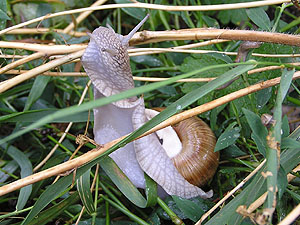
The cumbersome progress of a Roman snail on a way through
the undergrowth reveals the underside of the foot sole. [RN]
|
Morphology In biology the subject dealing with the construction and function of creature's body parts is referred to as morphology. In general, like on this page, morphology can be divided into external morphology (the external appearance) and internal morphology (the construction of organs and organ systems). While the external appearance of an animal can be seen by observing, the snail must be killed and dissected to see the internal morphology, which is why organ function is hard to observe in a living animal. |
Observing a living snail crawling its way, it is easy to see the difference between the soft, flexible living body covered in mucus and the hard, lifeless shell. Because a Roman snail is noticeably larger than most other terrestrial snails, it is not hard to see parts of the living body and how they function.
It is hard to say where one body part of a snail ends and another begins, but looking at the function of different parts of a snail's body it is easy to see the difference.
 The cumbersome progress of a Roman snail on a way through the undergrowth reveals the underside of the foot sole. [RN] |
What is visible outside of the shell, when a snail is crawling around, can be divided into two functional parts: The larger part is flattened below to form a sole, on which the snail moves. It is therefore called the snail's foot. The front part bears two pairs of tentacles, the larger of which each carry an eye. As head and foot cannot be clearly divided into separate parts, they are also called head-foot (cephalopodium).
On the snail's back there is the visceral hump, which contains vital internal organs, such as a large part of the digestive system. It is surrounded by a protective tissue layer called the mantle (pallium). The mantle is folded to a particularly thick layer in the shell mouth (aperture). There also a large opening can be seen in the mantle, the respiratory hole, opening to the mantle cavity beneath.
![]() Body parts and organs of a Roman snail.
Body parts and organs of a Roman snail.
Snails are as notoriously slimy as they are proverbially slow. All that is visible of a snail's body is covered in mucus or slime. Many gland cells are dispersed over a snail's body surface and constantly produce mucus.
Generally a snail's mucus is very viscous, but it may also be nearly as liquid as water. It is possible to smear it between the fingers, but it is usually quite difficult to wash it off, as the slime does not appear to dissolve in water. The reason is, snail slime consists of a mixture of muco-proteins, that swell in water like sponges, drawing water instead of releasing it. So in spite of their evolution taking outside of the sea since millions of years, terrestrial snails still always carry a coat of water with them. This efficient protection against evaporation is of vital importance to snails.
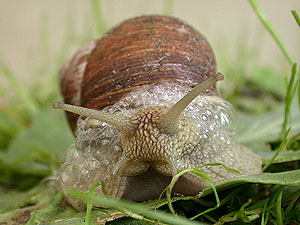 Snails can foam to protect themselves against harmful agents or against other disturbances. Picture: Ingrid Mittelstaedt. |
A terrestrial snail's slime not only protects it against drying out. At an older age, Roman snails may be protected effectively by the thick walls of their shell, but smaller snails, such as the colourful banded snails (Cepaea), are easily cracked by birds, like song thrushes.
Against smaller attackers, such as ants or carabid beetles, however thick the shell walls may be, there is no effective defence, because it is impossible to close the shell mouth (aperture): Most terrestrial snails such as the Roman snail, have no shell lid (operculum). To protect itself against such small enemies, the snail produces large amounts of watery slime bubbled up with air blown from the mantle cavity. That way ants are prevented from reaching the snail and get stuck in the slime. Some snails also can make a grunting or hissing sound doing so. A smaller relative of the Roman snail, the green snail, got its scientific name (Cantareus apertus), that literally means "singing snail", from that ability.
The Roman snail not only foams, when it is attacked, but also if it gets into contact with an unpleasant substance, such as an acid. Obviously the fluid mucus also is used to wash off harmful substances.
A snail's head is where most of its sense organs are concentrated. So it is the snail's sense centre, and, as snails usually move decisively in one direction, also the orientation centre. When it moves, the snail continuously orientates in its vicinity by moving around its tentacles in a searching motion. Most terrestrial snails possess four tentacles arranged in two pairs on the head. The shorter, lower pair of tentacles is pointed to the ground and used as feelers (which is essentially what ‘tentacles' means). The larger tentacles, on the other hand, are primarily eye stalks used to give the eyes a larger visual field. In the mollusc group, a Roman snail's eyes are among the most highly developed light sense organs: They are lens eyes, like those of a vertebrate animal. As there are not enough different types of sensory cells in a snail's eye, it can only see black and white. The lens also is not so flexible, as in a mammal's eye, so a Roman snail is probably quite short-sighted.
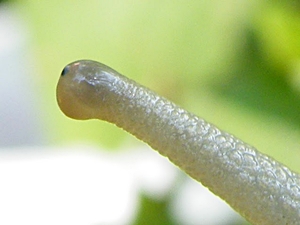 A Roman snail's eye stalk. Picture: Martina Eleveld. |
The eye's light sense cells are not the only sensory cells that give a snail information on its surroundings. Both tentacle pairs are densely set with sensory cells of smell and taste, which the snail can use to find food or mating partners. The lips, which are below the short tentacle pair, also are densely set with taste cells.
When the snail feeds, the mouth opening becomes visible beneath the lips. Here the digestion system begins. The anus however is located somewhere else, like several terminal openings, near the respiratory hole in the snail's mantle fold. Usually on the right side of a Roman snail's body there is another opening, easily recognised by the groove leading to it – the genital opening. It is especially well visible when the snail is mating.
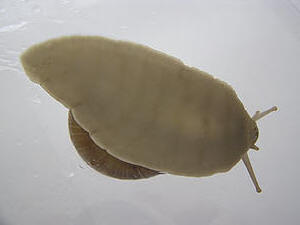 The underside of a crawling Roman snail. The dark transversal bands are waves of the foot sole, by which the snail moves. In the left part of the picture the snail's characteristic slime trace can be seen. [RN] |
A Roman snail's foot is specialised in a crawling motion. That is why its underside, the foot sole, is flat to make a gliding surface. In contrary to that the upper side of the foot is full of wrinkles, which act as capillaries additionally guiding water to the snail's body.
Other than the visible movement of its head and tentacles in a searching way, a snail's locomotion happens imperceptibly. The snail moves, albeit proverbially slow. But aside from that it is hard to see, how exactly the snail does it. Seen from below through a glass plate, however one can observe dark transversal bands moving over the snail's foot sole from back to front. The snail creates those bands by lifting its tail from the ground and putting it back a bit further front. The forming wave is visible from below as a dark transversal band. When it has gone all along the foot sole, the snail has moved a small distance.
![]() Movie:
Underside of a crawling snail
(Cornu aspersum). [RN] MOV-File, ca. 2 MB.
Movie:
Underside of a crawling snail
(Cornu aspersum). [RN] MOV-File, ca. 2 MB.
Like it is visible in the picture on the left, the bands do not cover all of the foot's width, but the foot sole's seam always remains in contact with the ground. That makes it possible for the snail to stay in contact with the ground at all times, even if a part of the sole if lifted off. So the snail can avoid being hurt by thorns or to fall off, even crawling upside down. The suction of a snail's foot can clearly be observed trying to pick it up, especially from a smooth surface. A snail clinging to the surface is amazingly strong.
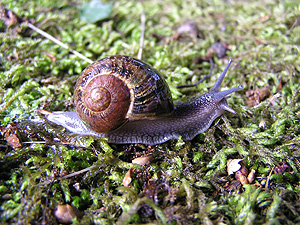 Movie of a crawling snail (Cornu aspersum). [RN] MOV-File, ca. 5 MB. |
Wherever a snail has found its way, it leaves a significant slime trace. A large slime gland opens shortly beneath the mouth opening. A large mucus gland produces a slime bed the snail glides on and that it leaves behind as slime trace. The mucus reduces friction between the snail's foot sole and the ground. That is why a Roman snail even can glide over a knife blade without hurting itself.
A part of a snail's body never leaves the shell, as long as the animal is alive. To see those body parts, a dead snail's shell must be removed. Then it can be seen, that those body parts of a snail are sack-shaped and coiled spirally, just like the shell itself. In this body part's interior there are numerous internal organs of the snail, such as the large digestive gland, part of whose function is that of the human liver. Because it contains internal organs, this part of a snail's body is called visceral sac or visceral hump. It is protected externally by a stout tissue layer, which is folded to a particularly resistant fold in the shell mouth or aperture. This tissue layer is called the mantle or pallium of the snail. Together with the visceral hump it is also called the viscero-pallial complex.
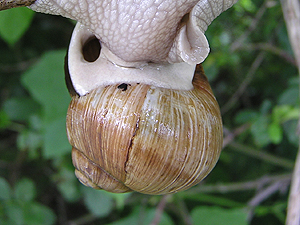 A living Roman snail's shell mouth. From this point of view the mantle and the respiratory hole are easily recognisable. [RN] |
The mantle fold in the shell mouth is a special adaptation of terrestrial snails not found among aquatic snails. It specially protects the snail against drying out by evaporation. A main cause for evaporation is a terrestrial snail's respiration. That takes place in the mantle cavity beneath the respiratory hole. Other than aquatic snails, terrestrial ones breathe (almost) dry air, which results in a constant water loss by evaporation. The thick mantle fold reduces evaporation to a high degree, but there must also be an air exchange to allow respiration. That is why the snail can control the size of the respiratory opening by a circular muscle.
The mantle, however, not only reduces evaporation, it also builds the shell.
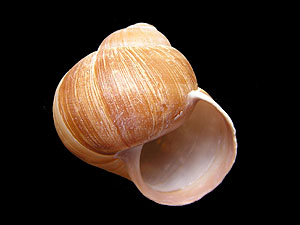 Most Roman snails' shells are dextral – the shell mouth is right of the shell's longitudinal axis. [RN] |
Freshly hatched Roman snails already carry a small glassily translucent shell. By an age of about three years, the snail is mature. Its shell is about three centimetres in diameter, opaque and very hard. Until a snail's maturity its shell grows with it – in size as in wall thickness. Gland cells on the mantle rim folds produce a calcareous secretion, that hardens to form the main shell layer. Special gland cells on the outermost mantle rim cover this layer with an organic skin, protecting it against corrosion. Other gland cells are dispersed over all of the mantle's surface and thicken the shell wall with further layers of shell matter. The largest part of a snail's shell is made from calcium carbonate, which in nature, for example, is contained in limestone.
During their evolutionary history, snails' visceral humps were coiled to one side of the body to save space. As a consequence, also a snail's shell is coiled to one side of the body, among Roman snails usually it is the right side, which is why those snails are called dextral. In addition to those right-handed snails there are also very rare, left-handed or sinistral specimens. Those, because they are so special, are called snail kings.